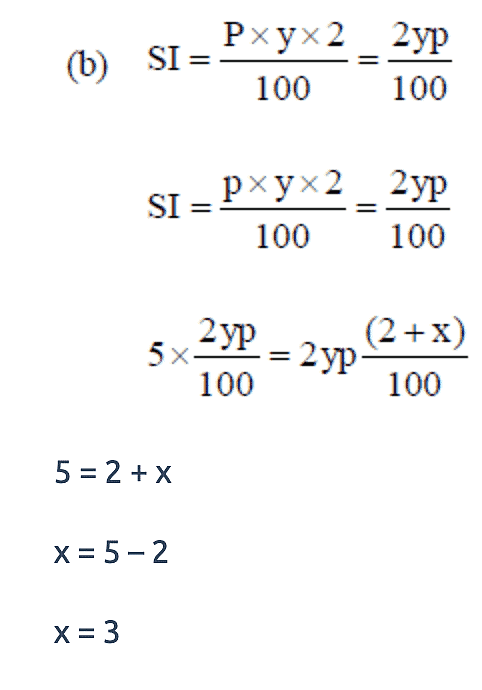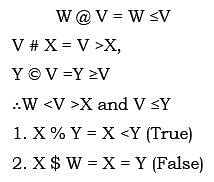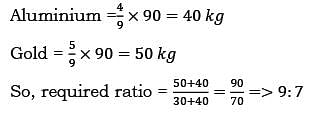OPSC OAS Prelims Paper 2 Mock Test - 5 - OPSC OCS (Odisha) MCQ
30 Questions MCQ Test OPSC OAS Mock Test Series 2024 - OPSC OAS Prelims Paper 2 Mock Test - 5
If Q means 'add to', J means 'multiply by', T means 'subtract from' and K means 'divide by' then 40 K 4 Q 5 J 2 T 6 =?
An amount is lent at y% p.a. simple interest for two years. Instead, had it been lent at 2y% p.a. simple interest for y more years, then the interest would have been five times the earlier interest. Find the value of y.
| 1 Crore+ students have signed up on EduRev. Have you? Download the App |
Present ages of Rajeev and Anand are in the ratio of 7: 10 respectively. Five years hence, the ratio of their ages will become 8: 11 respectively. If the Sum of the present age of Rajeev and Anand is ab. then, find what the unit digit of (ab) is?
Excluding stoppages, the speed of a train is 60 km/h and including stoppages the speed of the train is 50 km/h. For how much time does the train stops per hour?
One-way governments can decrease air pollution is to impose a tax on industrial carbon dioxide emissions. But why should governments consider a carbon tax when they could control emissions by establishing energy efficiency and conservation standards, by legislating against coal use, or by increasing investment in nuclear? The great virtue of such a tax is that it would provide incentives for industry to achieve emission reductions. Because oil emits more carbon dioxide per unit of energy generated than does natural gas, and coal more than oil, a carbon tax would vary with the type of fuel. Such a tax would induce industry to substitute less-polluting fuels for those carrying a higher tax and also to reduce the total use of energy.
Q. Which one of the following circumstances would most seriously undermine the conclusion “Such a tax would induce industry to substitute less- polluting fuels for those carrying a higher tax”
"Popular art" has a number of meanings, impossible to define with any precision, which range from folklore to junk. The poles are clear enough, but the middle tends to blur. The Hollywood Western of the 1930‘s, for example, has elements of folklore, but is closer to junk than to high art or folk art. The case of Giuseppe Verdi is an interesting one: he took a popular genre, bourgeois melodrama set to music and, without altering its fundamental nature, transmuted it into high art. This remains one of the greatest achievements in music, and one that cannot be fully appreciated without recognizing the essential trashiness of the genre. As an example of such a transmutation, consider what Verdi made of the typical political elements of nineteenth-century opera. Generally, in the plots of these operas, a hero or heroine— usually portrayed only as an individual, unfettered by class—is caught between the immoral corruption of the aristocracy and the doctrinaire rigidity or secret greed of the leaders of the proletariat. Verdi transforms this naive and unlikely formulation with music of extraordinary energy and rhythmic vitality, music more subtle than it seems at first hearing. There are scenes and arias that still sound like calls to arms and were clearly understood as such when they were first performed. Such pieces lend an immediacy to the otherwise veiled political message of these operas and call up feelings beyond those of the opera itself. Or consider Verdi’s treatment of character. Before Verdi, there were rarely any characters at all in musical drama, only a series of situations which allowed the singers to express a series of emotional states. Any attempt to find coherent psychological portrayal in these operas is misplaced ingenuity. The only coherence was the singer’s vocal technique.
Q. According to the passage, the immediacy of the political message in Verdi’s operas stems from the
"Popular art" has a number of meanings, impossible to define with any precision, which range from folklore to junk. The poles are clear enough, but the middle tends to blur. The Hollywood Western of the 1930‘s, for example, has elements of folklore, but is closer to junk than to high art or folk art. The case of Giuseppe Verdi is an interesting one: he took a popular genre, bourgeois melodrama set to music and, without altering its fundamental nature, transmuted it into high art. This remains one of the greatest achievements in music, and one that cannot be fully appreciated without recognizing the essential trashiness of the genre. As an example of such a transmutation, consider what Verdi made of the typical political elements of nineteenth-century opera. Generally, in the plots of these operas, a hero or heroine— usually portrayed only as an individual, unfettered by class—is caught between the immoral corruption of the aristocracy and the doctrinaire rigidity or secret greed of the leaders of the proletariat. Verdi transforms this naive and unlikely formulation with music of extraordinary energy and rhythmic vitality, music more subtle than it seems at first hearing. There are scenes and arias that still sound like calls to arms and were clearly understood as such when they were first performed. Such pieces lend an immediacy to the otherwise veiled political message of these operas and call up feelings beyond those of the opera itself. Or consider Verdi’s treatment of character. Before Verdi, there were rarely any characters at all in musical drama, only a series of situations which allowed the singers to express a series of emotional states. Any attempt to find coherent psychological portrayal in these operas is misplaced ingenuity. The only coherence was the singer’s vocal technique.
Q. According to the passage, all of the following characterize musical drama before Verdi EXCEPT:
"Popular art" has a number of meanings, impossible to define with any precision, which range from folklore to junk. The poles are clear enough, but the middle tends to blur. The Hollywood Western of the 1930‘s, for example, has elements of folklore, but is closer to junk than to high art or folk art. The case of Giuseppe Verdi is an interesting one: he took a popular genre, bourgeois melodrama set to music and, without altering its fundamental nature, transmuted it into high art. This remains one of the greatest achievements in music, and one that cannot be fully appreciated without recognizing the essential trashiness of the genre. As an example of such a transmutation, consider what Verdi made of the typical political elements of nineteenth-century opera. Generally, in the plots of these operas, a hero or heroine— usually portrayed only as an individual, unfettered by class—is caught between the immoral corruption of the aristocracy and the doctrinaire rigidity or secret greed of the leaders of the proletariat. Verdi transforms this naive and unlikely formulation with music of extraordinary energy and rhythmic vitality, music more subtle than it seems at first hearing. There are scenes and arias that still sound like calls to arms and were clearly understood as such when they were first performed. Such pieces lend an immediacy to the otherwise veiled political message of these operas and call up feelings beyond those of the opera itself. Or consider Verdi’s treatment of character. Before Verdi, there were rarely any characters at all in musical drama, only a series of situations which allowed the singers to express a series of emotional states. Any attempt to find coherent psychological portrayal in these operas is misplaced ingenuity. The only coherence was the singer’s vocal technique.
Q. It can be inferred that the author regards the independence from social class of the heroes and heroines of nineteenth- century opera as
Although pathogenic organisms constantly alight on the skin, they find it a very unfavourable environment and, in the absence of injury, have great difficulty colonizing it. This "self-sterilizing" capacity of the skin results from the tendency of all well-developed ecosystems toward homeostasis, or the maintenance of the status quo. Species that typically live in
soil, water, and elsewhere rarely multiply on the skin. Undamaged skin is also unfavourable to most human pathogens. The skin is too acid and too arid for some species. The constant shedding of the surface skin layers further hinders the establishment of invaders. The most interesting defence mechanism, however, results from the metabolic activities of the resident flora. Unsaturated fatty acids, an important component of the lipids in sebum collected from the skin surface, inhibit the growth of several bacterial and fungal cutaneous pathogens. These acids are a metabolic product of certain gram-positive members of the cutaneous community, which break down the more complex lipids in freshly secreted sebum.
Q. The primary purpose of the passage is to
Although pathogenic organisms constantly alight on the skin, they find it a very unfavourable environment and, in the absence of injury, have great difficulty colonizing it. This "self-sterilizing" capacity of the skin results from the tendency of all well-developed ecosystems toward homeostasis, or the maintenance of the status quo. Species that typically live in
soil, water, and elsewhere rarely multiply on the skin. Undamaged skin is also unfavourable to most human pathogens. The skin is too acid and too arid for some species. The constant shedding of the surface skin layers further hinders the establishment of invaders. The most interesting defence mechanism, however, results from the metabolic activities of the resident flora. Unsaturated fatty acids, an important component of the lipids in sebum collected from the skin surface, inhibit the growth of several bacterial and fungal cutaneous pathogens. These acids are a metabolic product of certain gram-positive members of the cutaneous community, which break down the more complex lipids in freshly secreted sebum.
Q. The "resident flora” mentioned refer to
Directions : Symbols %, #, $, © are used with different meanings as explained below:
1. ‘P @ Q’ means ‘P is not greater than Q’.
2. ‘P % Q’ means ‘P is neither greater than nor equal to Q’.
3. ‘P # Q’ means ‘P is neither smaller than nor equal to Q’.
4. ‘P $ Q’ means ‘P is neither smaller than nor greater than Q’.
5. ‘P © Q’ means ‘P is not smaller than Q’.
Q. Three statements showing relationships have been given, which are followed by two conclusions (1) and (2). Assuming that the given statements are true, find out which conclusions(s) is/are definitely true.
Statements: W @ V, V # X, Y © V.
Conclusions:
X % Y
X $ W
Read the following information carefully and answer the questions that follow—
A, B, C, D, E and F are six students procuring their Master’s Degree in six different subjects—Data science, Finance, Criminal Justice, Fine arts, Economics and Music.
Two of them stay in hostel, two stay as paying guest (PG) and the remaining two stay at their home.
C does not stay as PG and studies Fine Arts.
The students studying Economics and Finance do not stay as PG.
E studies Music and D studies, Criminal Justice. F and D stay in Hostel. E stays as PG and B stays at home.
Q. Who studies Data science?
Read the following information carefully and answer the questions that follow—
A, B, C, D, E and F are six students procuring their Master’s Degree in six different subjects—Data science, Finance, Criminal Justice, Fine arts, Economics and Music.
Two of them stay in hostel, two stay as paying guest (PG) and the remaining two stay at their home.
C does not stay as PG and studies Fine Arts.
The students studying Economics and Finance do not stay as PG.
E studies Music and D studies, Criminal Justice. F and D stay in Hostel. E stays as PG and B stays at home.
Q. Which of the following combination of subjects and place of stay is not correct?
Read the following information carefully and answer the questions that follow—
A, B, C, D, E and F are six students procuring their Master’s Degree in six different subjects—Data science, Finance, Criminal Justice, Fine arts, Economics and Music.
Two of them stay in hostel, two stay as paying guest (PG) and the remaining two stay at their home.
C does not stay as PG and studies Fine Arts.
The students studying Economics and Finance do not stay as PG.
E studies Music and D studies, Criminal Justice. F and D stay in Hostel. E stays as PG and B stays at home.
Q. Which of the following pairs of students stay one each at hostel and at home?
Read the following information carefully and answer the questions that follow—
A, B, C, D, E and F are six students procuring their Master’s Degree in six different subjects—Data science, Finance, Criminal Justice, Fine arts, Economics and Music.
Two of them stay in hostel, two stay as paying guest (PG) and the remaining two stay at their home.
C does not stay as PG and studies Fine Arts.
The students studying Economics and Finance do not stay as PG.
E studies Music and D studies, Criminal Justice. F and D stay in Hostel. E stays as PG and B stays at home.
Q. Which subject does B study?
Consider two alloys A and B. 70 kg of alloy A is mixed with 90 kg of alloy B. A contains Aluminium and Gold in the ratio 3: 4, and B contains them in the ratio 4: 5 respectively. What is the ratio of Gold to Aluminium in the mixture?
A Salesman charges sales tax of x% upto Rs. 4,000 and above it he charges y%.
A customer pays total tax of Rs 400, when he purchases the goods worth Rs. 6,000 and he pay’s the total tax of Rs. 2200 for the goods worth Rs. 24,000. The value of x and y is:
For some time, scientists have believed that cholesterol plays a major role in heart disease because people with familial hypercholesterolemia, a genetic defect, have six to eight times the normal level of cholesterol in their blood and they invariably develop heart disease. Scientists also noticed that people with familial hypercholesterolemia appear to produce more LDL’s (low-density lipoproteins) than normal individuals. However, scientists wondered, could a genetic mutation that causes a slowdown in the removal of LDL’s from the blood also result in an increase in the synthesis of this cholesterol-carrying protein? Since scientists could not experiment on human body tissue, their knowledge of familial hypercholesterolemia was severely limited. However, a breakthrough came in the laboratories of Yoshio Watanabe of Kobe University in Japan in 1980. Watanabe noticed that a male rabbit in his colony had ten times the normal concentration of cholesterol in its blood. By appropriate breeding, Watanabe obtained a strain of rabbits that had very high cholesterol levels. These rabbits spontaneously developed heart disease. To his surprise, Watanabe further found that the rabbits, like humans with familial hypercholesterolemia, lacked LDL receptors. What scientists learned by studying the Watanabe rabbits is that the removal of the VLDL (very low-density lipoproteins) remnant requires the LDL receptor. Normally, the majority of the VLDL remnants go to the liver where they bind to LDL receptors and are degraded. In the Watanabe rabbit, due to a lack of LDL receptors on liver cells, the VLDL remnants remain in the blood and are eventually converted to LDL’s. The LDL receptors thus have a dual effect in controlling LDL levels. They are necessary to prevent over synthesis of LDL’s from VLDL remnants and they are necessary for the normal removal of LDL’s from the blood.
Q. The passage supplies information to answer which of the following questions?
For some time, scientists have believed that cholesterol plays a major role in heart disease because people with familial hypercholesterolemia, a genetic defect, have six to eight times the normal level of cholesterol in their blood and they invariably develop heart disease. Scientists also noticed that people with familial hypercholesterolemia appear to produce more LDL’s (low-density lipoproteins) than normal individuals. However, scientists wondered, could a genetic mutation that causes a slowdown in the removal of LDL’s from the blood also result in an increase in the synthesis of this cholesterol-carrying protein? Since scientists could not experiment on human body tissue, their knowledge of familial hypercholesterolemia was severely limited. However, a breakthrough came in the laboratories of Yoshio Watanabe of Kobe University in Japan in 1980. Watanabe noticed that a male rabbit in his colony had ten times the normal concentration of cholesterol in its blood. By appropriate breeding, Watanabe obtained a strain of rabbits that had very high cholesterol levels. These rabbits spontaneously developed heart disease. To his surprise, Watanabe further found that the rabbits, like humans with familial hypercholesterolemia, lacked LDL receptors. What scientists learned by studying the Watanabe rabbits is that the removal of the VLDL (very low-density lipoproteins) remnant requires the LDL receptor. Normally, the majority of the VLDL remnants go to the liver where they bind to LDL receptors and are degraded. In the Watanabe rabbit, due to a lack of LDL receptors on liver cells, the VLDL remnants remain in the blood and are eventually converted to LDL’s. The LDL receptors thus have a dual effect in controlling LDL levels. They are necessary to prevent over synthesis of LDL’s from VLDL remnants and they are necessary for the normal removal of LDL’s from the blood.
Q. According to the passage, by studying the Watanabe rabbits’ scientists learned that
For some time, scientists have believed that cholesterol plays a major role in heart disease because people with familial hypercholesterolemia, a genetic defect, have six to eight times the normal level of cholesterol in their blood and they invariably develop heart disease. Scientists also noticed that people with familial hypercholesterolemia appear to produce more LDL’s (low-density lipoproteins) than normal individuals. However, scientists wondered, could a genetic mutation that causes a slowdown in the removal of LDL’s from the blood also result in an increase in the synthesis of this cholesterol-carrying protein? Since scientists could not experiment on human body tissue, their knowledge of familial hypercholesterolemia was severely limited. However, a breakthrough came in the laboratories of Yoshio Watanabe of Kobe University in Japan in 1980. Watanabe noticed that a male rabbit in his colony had ten times the normal concentration of cholesterol in its blood. By appropriate breeding, Watanabe obtained a strain of rabbits that had very high cholesterol levels. These rabbits spontaneously developed heart disease. To his surprise, Watanabe further found that the rabbits, like humans with familial hypercholesterolemia, lacked LDL receptors. What scientists learned by studying the Watanabe rabbits is that the removal of the VLDL (very low-density lipoproteins) remnant requires the LDL receptor. Normally, the majority of the VLDL remnants go to the liver where they bind to LDL receptors and are degraded. In the Watanabe rabbit, due to a lack of LDL receptors on liver cells, the VLDL remnants remain in the blood and are eventually converted to LDL’s. The LDL receptors thus have a dual effect in controlling LDL levels. They are necessary to prevent over synthesis of LDL’s from VLDL remnants and they are necessary for the normal removal of LDL’s from the blood.
Q. The passage implies that Watanabe rabbits differ from normal rabbits in which of the following ways?
"I want to criticize the social system, and to show it at work, at its most intense." Virginia Woolf’s provocative statement about her intentions in writing Mrs. Dalloway has regularly been ignored by the critics, since it highlights an aspect of her literary interests very different from the traditional picture of the "poetic” novelist concerned with examining states of reverie and vision and with following the intricate pathways of individual consciousness. In her novels, Woolf is deeply engaged by the questions of how individuals are shaped (or
deformed) by their social environments, how historical forces impinge on people’s lives, how class, wealth, and gender help to determine people’s fates. Most of her novels are rooted in a realistically rendered social setting and in a precise historical time.Woolf’s focus on society has not been generally recognized because of her intense antipathy to propaganda in art. The pictures of reformers in her novels are usually satiric or sharply critical.Woolf detested what she called "preaching" in fiction, too, and criticized novelist D. H. Lawrence (among others) for working by this method. Woolf’s own social criticism is expressed in the language of observation rather than in direct commentary, since for her, fiction is a contemplative, not an active art. Woolf’s literary models were acute social observers like Chekhov and Chaucer. As she put it in The Common Reader, "It is safe to say that not a single law has been framed or one stone set upon another because of anything Chaucer said or wrote; and yet, as we read him, we are absorbing morality at every pore."
Q. It can be inferred from the passage that Woolf chose Chaucer as a literary model because she believed that
"I want to criticize the social system, and to show it at work, at its most intense." Virginia Woolf’s provocative statement about her intentions in writing Mrs. Dalloway has regularly been ignored by the critics, since it highlights an aspect of her literary interests very different from the traditional picture of the "poetic” novelist concerned with examining states of reverie and vision and with following the intricate pathways of individual consciousness. In her novels, Woolf is deeply engaged by the questions of how individuals are shaped (or
deformed) by their social environments, how historical forces impinge on people’s lives, how class, wealth, and gender help to determine people’s fates. Most of her novels are rooted in a realistically rendered social setting and in a precise historical time.Woolf’s focus on society has not been generally recognized because of her intense antipathy to propaganda in art. The pictures of reformers in her novels are usually satiric or sharply critical.Woolf detested what she called "preaching" in fiction, too, and criticized novelist D. H. Lawrence (among others) for working by this method. Woolf’s own social criticism is expressed in the language of observation rather than in direct commentary, since for her, fiction is a contemplative, not an active art. Woolf’s literary models were acute social observers like Chekhov and Chaucer. As she put it in The Common Reader, "It is safe to say that not a single law has been framed or one stone set upon another because of anything Chaucer said or wrote; and yet, as we read him, we are absorbing morality at every pore."
Q. It can be inferred from the passage that the most probable reason Woolf realistically described the social setting in the majority of her novels was that she
A father is six times as old as his son and the mother is five times as old as the son. Let the age of son be "x" then the sum of the father's and the mother's age is [(x - 1)2 - 1] years. What is the age of the son?
The ratio of milk and water in a mixture of 24 liters is 1:1. How much water must be added to the mixture so that the ratio of milk and water be 1:2?
Find % change in the breadth of a rectangle if the length of a rectangle is
doubled and the area remains fixed.
If 4+9= 18, 5+8=20 and 5+6 =15, then the value of 8+112=?
Consider the following and answer the question based on it.
-
Aayush’s playing schedule consists of Cricket, Hockey, Soccer, Tennis, and Volleyball from Monday to Saturday; each game is on one day, one day being a rest day.
-
Cricket is played neither on the first day nor on last day but is played earlier than Tennis.
-
Volleyball is played on the immediate next day of the tennis day.
-
Hockey is played on the immediate previous day of the rest day.
-
Volleyball and Soccer were played with a 2-day gap between them.
-
Soccer is played on the day following the rest day.
-
Q. Which of the following is a rest day?
Consider the following and answer the question based on it.
Aayush’s playing schedule consists of Cricket, Hockey, Soccer, Tennis, and Volleyball from Monday to Saturday; each game is on one day, one day being a rest day.
Cricket is played neither on the first day nor on last day but is played earlier than Tennis.
Volleyball is played on the immediate next day of the tennis day.
Hockey is played on the immediate previous day of the rest day.
Volleyball and Soccer were played with a 2-day gap between them.
Soccer is played on the day following the rest day.
Q. Hockey and Volleyball days have a gap of how many days between them?
Consider the following and answer the question based on it.
Aayush’s playing schedule consists of Cricket, Hockey, Soccer, Tennis, and Volleyball from Monday to Saturday; each game is on one day, one day being a rest day.
Cricket is played neither on the first day nor on last day but is played earlier than Tennis.
Volleyball is played on the immediate next day of the tennis day.
Hockey is played on the immediate previous day of the rest day.
Volleyball and Soccer were played with a 2-day gap between them.
Soccer is played on the day following the rest day.
Q. On which day is soccer played?
Consider the following and answer the question based on it.
Aayush’s playing schedule consists of Cricket, Hockey, Soccer, Tennis, and Volleyball from Monday to Saturday; each game is on one day, one day being a rest day.
Cricket is played neither on the first day nor on last day but is played earlier than Tennis.
Volleyball is played on the immediate next day of the tennis day.
Hockey is played on the immediate previous day of the rest day.
Volleyball and Soccer were played with a 2-day gap between them.
Soccer is played on the day following the rest day.
Q. Which of the following is a correct statement?






























